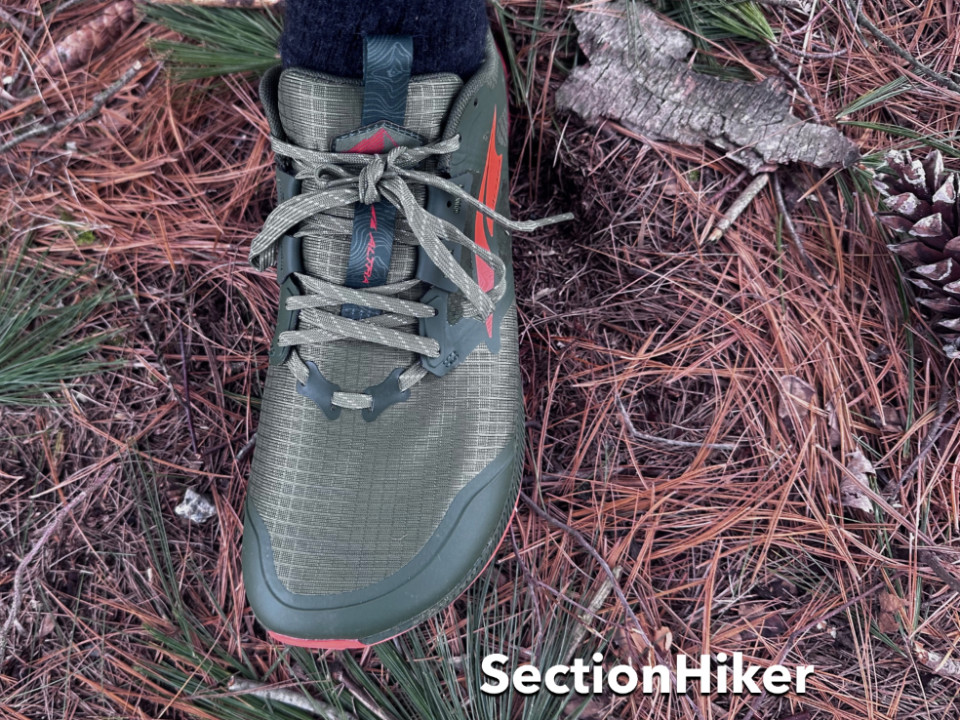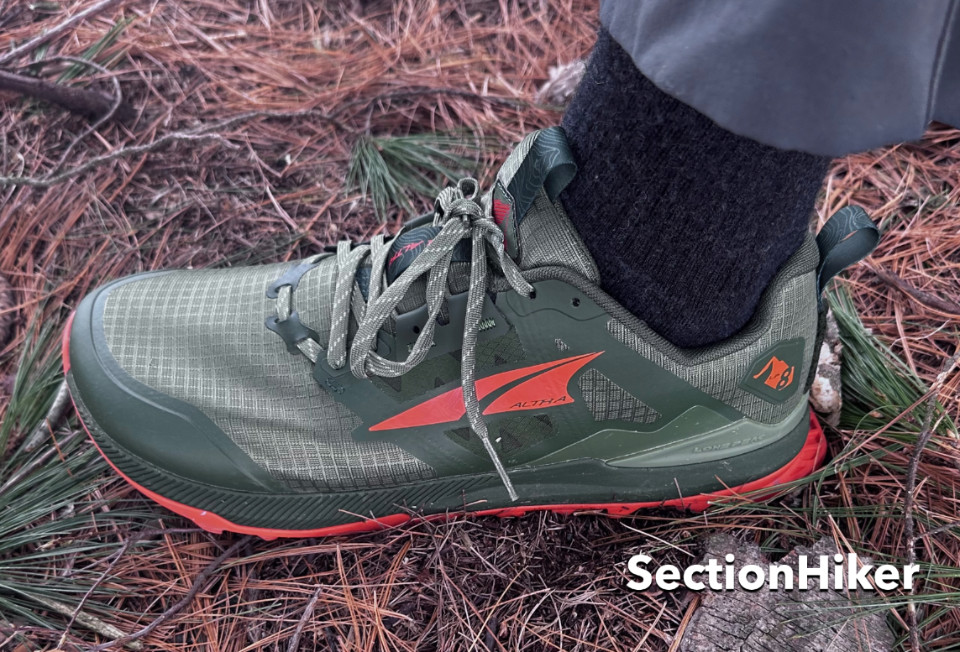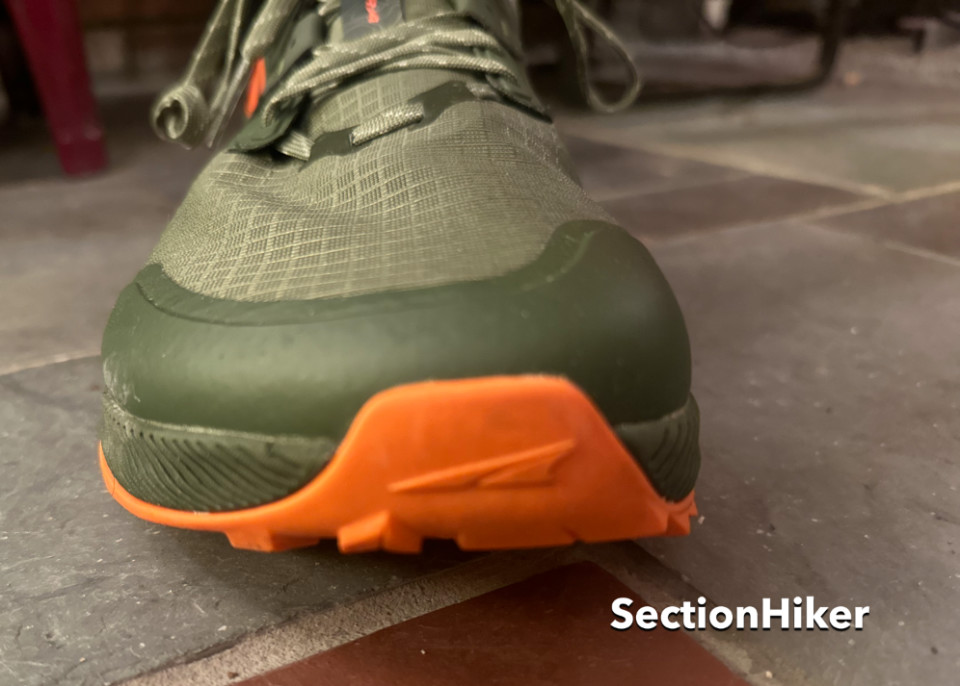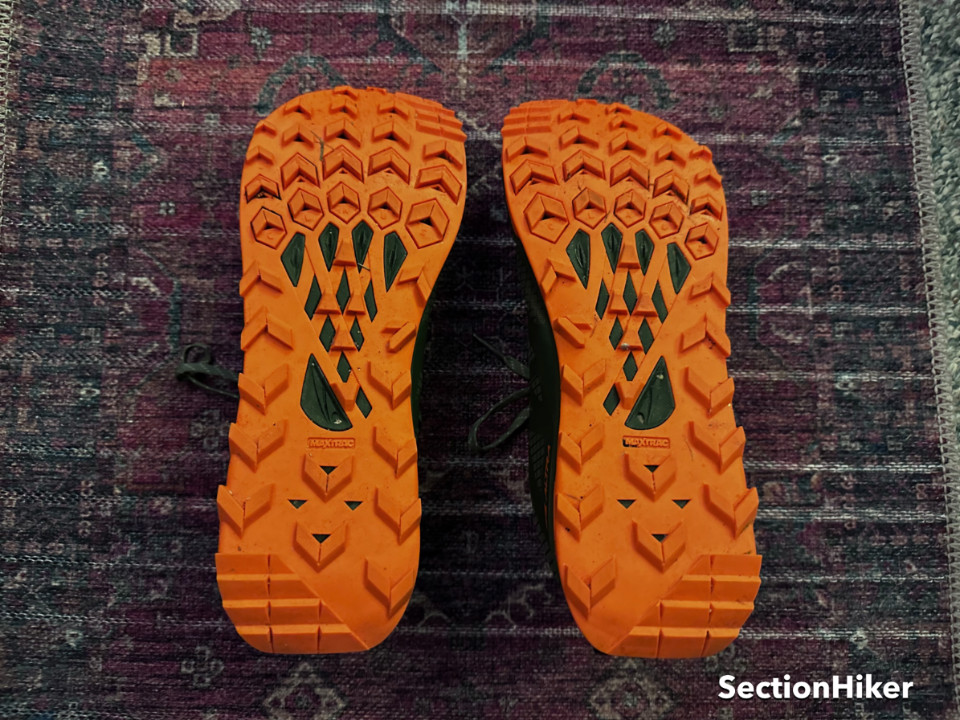The Altra Lone Peak 8 is a zero-drop trail running shoe that’s good for hiking and running across a wide range of conditions. It’s a moderately cushioned shoe with a very wide toe box so your toes can splay out and relax. The effect feels like you’re walking in bare feet with an enhanced degree of trail feel. A 25 mm stack height makes the Lone Peak 8 a fairly stable shoe and helps prevent ankle rolling. The shoes have grippy 5 mm multi-directional lugs with a rock plate and a rubber toe kick for protection, with well-draining mesh uppers that prevent sand and trail grit from entering and eating your socks.
RELATED: 10 Best Hiking Shoes and Trail Runners
Specs at a Glance
- Gender: Men’s (Women’s also available)
- Wide Sizes: Wide sizes are available in certain colors – visit Altra for best selection.
- Weight: 11 oz (men’s)
- Heel Drop: 0 mm
- Heel Stack Height: 25 oz mm
- Forefoot Stack Height: 25 mm
- Midsole: Proprietary Foam
- Outsole: Proprietary Outsole w/ 5 mm Lugs
- Rock Plate: Yes
- Gaiter Trap: Yes
- Width: Regular & Wide
- Weight (pair): 1 lb 6 oz
Trail Feel

The Altra Lone Peak 8 is a moderately cushioned trail running shoe that can be used for hiking, backpacking, and trail running. The shoe’s signature feature is an oversized toe box which lets your toes splay out as if you were walking barefoot through sand. This is very different from most modern shoes, including many trail runners, which still have narrow toe boxes that restrict toe movement, putting more pressure on the balls of your feet and metatarsals, and can result in longer-term conditions like Morton’s Neuroma, which manifests itself as a tingling or burning sensation in your toes. I suffer from Morton’s, and a shoe with a huge toe box like the Lone Peak helps eliminate my symptoms.
The Lone Peak is also a zero-drop trail running shoe meaning that the heel and the toes are level and an equal distance from the ground. The idea is that this allows for a more natural and more stable foot strike, mimicking the motion of barefoot steps, resulting in a more natural and efficient stride. It also means that impacts can be spread out across the entire surface of the foot.

One of my favorite features on the Lone Peak is the gaiter trap, located on the back of the heel of the shoe. It’s a piece of velcro that makes it very simple to wear a Dirty Girl Gaiter and removes the need to glue a strip of velcro there for that purpose. It also stays affixed permanently, whereas the homegrown velcro patches I have to glue on other trail runners fall off relatively quickly.
The Lone Peak 8 isn’t as wide in the heel or as long in the toebox compared to the previous model, even in a regular width size, which is a good thing as far as I’m concerned. The previous model tended to buckle and crease at the base of the toe box which I found annoying: it doesn’t do that anymore in version 8 of the shoe. The slightly smaller and shorter toebox also makes the Lone Peak 8 less sloppy on uphill climbs or scrambling across rocky terrain.
If it still feels too wide for you there are plenty of lace holes on the shoe to tighten the fit. If you still prefer a narrower fit, particularly in the heel, the Altra Superior will be a better choice.

Stability
The Lone Peak is very stable, in part because it’s a zero-drop shoe where your forefoot and heel are at the same height. With its 25 mm stack height, which is pretty average for a trail runner, it’s less prone to ankle rolling because you’re pretty close to the ground. That and the enhanced proprioception you get from walking with spayed toes make it much easier to sense changing trail conditions and terrain so you can adapt your stride accordingly.
Protection
As a trail runner, it is important to have a shoe that is going to protect the bottoms of your feet from what lies underfoot, but also have a breathable upper that allows your feet to ventilate while also keeping out particulates of mud, sand, and grit that will wreak havoc on your socks.
The Lone Peak 8 does both. The finely pored breathable mesh of the upper does a good job of keeping your feet cool while preventing coarse sand and grit from entering the shoe. Drainage is also excellent for those times, especially in spring, when you can’t avoid giant mud pits or high stream crossings. This is a big deal since many trail runners with large-pored mesh uppers fail miserably on this dimension, especially in sandy desert terrain.

The Lone Peak 8 has a rock plate (Altra calls it a Stone Guard), which is a must-have for hiking on more technical rocky trails. It’s embedded between the outsole and the midsole of the shoe for underfoot protection and helps protect the soles of your feet from being bruised by any of the sharp rocks and stones that you may walk over.
There’s also a well-padded rubber toe kick in front of the toes, slightly off-center and positioned in front of the big toe, although I wish it extended further down the sides of the toe box for more protection. While there is a soft rubber rand that runs along the outside of the toe box, it doesn’t cushion impacts as much as protect the mesh upper from abrasion.
Traction
The Lone Peak 8 has multi-directional 5 mm lugs, that provide a good grip on trails and rock. The key to their success is how soft the rubber is. This soft rubber is key to providing traction, particularly on wet surfaces, similar to the softer rubber used in snow and all-weather car tires. However, be forewarned that the soles tend to wear out fairly quickly, somewhere between 250-400 miles, especially if you hike or run in rocky terrain. While Altra soles provide adequate traction on wet rock, shoes made by a climbing shoe company like La Sportiva perform much better in such conditions, although the mileage you get out of them will also be comparable.
The Lone Peaks lugs are deliberately arranged on the bottom of the sole and sized and oriented for different functions. For example, the lugs under the metatarsals at the ball of the foot are the largest and designed to provide traction when running or climbing on steep terrain. The lugs toward the rear of the shoe are oriented in the opposite direction to enhance braking and widely spaced to enhance drainage, while there are reinforced areas under the big toe and on the outside of the heel to make the sole last longer.

Interspersed in and among the lugs are drain holes to shed water if the shoes get soaked, for example, in a stream crossing. The drains are fed by a circular hole cut into the footbed under the ball of the foot and below the insole that comes with the shoe. While most of the water that gets into the shoe drains through the mesh upper, some does make it under the insole and through this drainage port. Good drainage in a trail runner is a must-have if you hike in a wet climate with a lot of stream crossings.
Recommendation
Altra Lone Peak 8 Trail Runners are a good choice if you are someone who is looking for a trail shoe that provides a lot of ground feel, a moderate degree of protection, and a moderate cushion. They have a large toe box that lets your toes splay out and relax with aggressive lugs underfoot that are positioned and oriented to provide enhanced traction and braking. This new version is true to size, which is another difference from the previous very which tended to run a bit wide and long. If you want a narrower fit we recommend that you try the Altra Superior 6 trail runner instead.
While zero-drop shoes like the Lone Peak do promote a more “natural” stride like that of walking barefoot, they put a lot more stress on your lower legs and feet than shoes where the heels are higher than the toes. You’re best off transitioning to the Lone Peaks or other zero-drop shoes over a period of 4-6 weeks to stretch and strengthen your feet and calves before running off to hike in them on a long-distance thru-hike or a high-mileage day hike.
